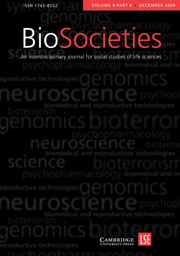Article contents
Race, Risk and Medicine in the Age of ‘Your Own Personal Genome’
Published online by Cambridge University Press: 01 December 2008
Abstract
The intertwined genealogies of racialization and medicalization are mutating once more, with the much heralded arrival of personal genomics. A proliferation of commercial organizations now offer web-based services that, on the basis of an analysis of a DNA sample from a cheek swab and at the cost of a few hundred dollars, promise to scan millions of variations in ‘my genome’ and to tell me where my ancestors came from, to compare my genome with others, and to enable me to calculate my risk for dozens of diseases and conditions from age-related macular degeneration, through Alzheimer's disease and prostate cancer, to restless legs. These new forms of genetic information arise in part from a crisis in genomic medicine, combined with a radical reduction in the costs of gene sequencing. They are linked to a new form of thinking about the genomic bases of disease that link ancestry and medicine in new ways. These cannot be understood simply by deploying the familiar tropes of sociological and anthropological critique—by repeating that ‘race has no biological meaning’. In this article I try to characterize the new ways of thinking about individuals and populations, about risk and responsibility, and about race and population differentiation that are taking shape, and explore their personal and social implications.
- Type
- Lecture
- Information
- Copyright
- Copyright © London School of Economics and Political Science 2008
References
- 24
- Cited by


